Collaboration is a delicate, sensitive process whose outcomes are determined by an indefinite number of factors.
It doesn’t only need to be properly organized, but also carefully curated, modified, and maintained throughout the various stages and aspects of its course.
If you spend enough time involved in collaborative work, its numerous benefits will surely reveal themselves. However, you will almost certainly also experience the stress, frustration, and inefficiency that unavoidably arise from time to time when working with others.
Collaboration itself does not inherently remove any of these downsides. Instead, it is up to teams and organizations to create an environment that makes it easy to eliminate, minimize, and/or manage them.
In this article, we focus on the practical applications of collaborative work and the key practices and principles that can help raise it to a higher level.

Why is productive team collaboration crucial for every company?
A long time ago, Hellen Keller said: “Alone we can do so little; together we can do so much.“
Steve Jobs implemented this notion into a business setting and said: “Great things in business are never done by one person; they’re done by a team of people.”
The importance of team collaboration has been undoubtedly acknowledged ever since ― especially in today’s hectic world, where companies face real issues in terms of enhancing team collaboration and productivity.
Burnout epidemic, the challenges of remote and hybrid work models, and the struggle to set work-life boundaries have led to the increased importance of effective team collaboration. But, achieving good team collaboration is certainly easier said than done.
On the other hand, collaborative overload is not a myth.
According to a Harvard Business Review article, collaborative overload is defined as the negative influence of too much teamwork, which leads to less productivity and employees feeling exhausted.
The data has shown that at many companies more than 80% of work time is spent on collaborative activities such as:
- Responding to emails,
- Making voice calls,
- Attending meetings, etc.
This number progressively increased through the pandemic ― as we mentioned, remote and hybrid work models have set up new challenges in terms of collaboration since virtual meetings have become the new normal on daily bases.
However, surveys show that 39% of employees believe that people in their organization don’t collaborate sufficiently.
All things considered, we can conclude that productive team collaboration requires maintaining a good balance. Even though team collaboration should be prioritized, it’s necessary to prevent collaborative overload by finding a balance with collaborative activities.
What are the key benefits of a collaborative team?
Before we dive into the best practices for productive team collaboration, let’s take a look at the greatest benefits of a collaborative team.
Benefit #1: A collaborative team contributes to problem-solving
“Two heads are better than one.”
― John Heywood
Team synergy empowers team collaboration with different perspectives that might bring some new values to the table. This helps team members to get their best work done.
In other words, two or more people are more likely to find relevant solutions and make better decisions than a single person.
Combining the knowledge of team members and sharing ideas and thoughts is one of the greatest powers of team collaboration.
Solve problems and brainstorm over Pumble
Benefit #2: Collaborative team encourages skill and knowledge sharing among team members
Aside from contributing to problem-solving, a strong collaborative culture allows team members to learn from each other.
Skill and knowledge sharing among team members with different backgrounds, levels of experience, and points of view leads to increased productivity.
Benefit #3: A collaborative team boosts productivity and engagement
According to a Forbes article about the influence of collaboration on employees’ productivity, a collaborative environment “makes an engaged workforce where each person feels like a contributing member of a unified team”.
Moreover, studies show that this experience empowers them with more intrinsic motivation, which leads to more engagement and 50% more effectiveness at completing tasks.
Therefore, the dynamic of effective collaboration doesn’t solely contribute to problem-solving and knowledge sharing, but also improves the mental health of the individuals involved.
5 Principles of good collaboration
In his highly influential work How to Make Collaboration Work, author David Straus set out to provide pointers for the creation of a productive collaborative environment that sidesteps the negative side effects of the process and emphasizes the values of collaboration and the joyful aspects of working together.
A lifelong explorer and practitioner of “collaborative problem-solving”, Straus has relied on decades of his experience as a leader, consultant, and trainer to distill 5 key principles of effective collaboration.
Straus’ 5 principles are:
- Involve the relevant stakeholders.
- Build consensus phase by phase.
- Design a process map.
- Designate a process facilitator.
- Harness the power of group memory.
Over the following lines, we will take a closer look at all of them.
Principle #1: Involve the relevant stakeholders
“The power of collaboration comes from inclusion, not exclusion.”
– David Straus
At first, it may seem obvious that collaboration should include everyone with an active interest in its outcome and/or the relevant expertise.
In practice, however, this is often not the case. Individuals and groups that can significantly impact the course of the collaboration are often excluded from the process.
This can happen unintentionally, when an organization fails to properly identify relevant participants, or intentionally, if a person or a group in question is deemed to be confrontational or opposed to the collaboration or the planned activities, despite possessing the relevant expertise or a say in the decision-making process.
To properly identify all relevant parties, Straus has come up with 4 categories of relevant stakeholders:
- Those with the formal power to make a decision,
- Those with the power to block a decision,
- Those affected by a decision, and
- Those with relevant information or expertise.
Keep everyone in the loop with Pumble
Category #1: Those with the formal power to make a decision
The involvement of formal decision-makers gives weight and relevance to the collaborative process. The more involved they are, the collaboration will be stronger and more impactful.
On the other hand, lack of involvement of decision-makers devalues the collaboration, as any decisions made jointly by the collaborative group can be dismissed on a higher level.
Category #2: Those with the power to block a decision
Unlike the first type of stakeholder, this type has no formal decision-making power, yet still has the power to significantly hinder the implementation of any decisions or block it entirely by:
- Failing to act,
- Withholding information,
- Phoning in work,
- Opposing through formal channels, etc.
Gaining the support of such individuals or groups can be crucial to the success of a collaboration.
Getting potential decision-blockers involved in collaboration makes the process stronger, while their exclusion will inevitably lead to resistance and threaten the implementation of the joint effort.
While the thought of excluding potentially troublesome collaborators may sound tempting, it would only give the blockers more power, as they could rightfully claim that the process wasn’t fair and inclusive. Conversely, their participation can lead to their full adoption of the process, if the rest of the team truly listens and considers their input.
Category #3: Those affected by a decision
The broadest group of stakeholders by default, those who are affected by the outcomes of the collaborative process, can involve an entire organization or a community.
In most cases, however, it includes a more narrow subset of individuals directly affected by the outcomes or concerned for them.
Involving this group is essential for several reasons:
1. If their input is considered in the decision-making process, they are more likely to support the decisions, while the exclusion of their viewpoints can easily turn them into decision-blockers.
2. As they will be most affected by the decisions, it is not only respectful but also highly practical to consider their input.
If the affected group is too large for practical matters (meetings, consultations, etc.), its voices can be heard through a chosen representative who will provide the group’s perspective.
Category #4: Those with relevant information or expertise
In most cases, the inclusion of the first three groups will provide the collaborative team with sufficient expertise.
However, this might not always be the case. It is important to properly assess the resources at hand and determine whether any additional expertise is required.
If the required expertise can not be found within the organization, it should consider hiring outside expertise.
Principle #2: Build consensus phase by phase
Decisions reached through consensus carry great importance for the collaborative process.
If decisions are made collectively, all participants will have a higher degree of investment in their implementation.
Additionally, consensus decisions tend to be better than decisions reached through a majority vote or hierarchical decision-making.
Reaching a consensus is not always a straightforward and easy process. Straus suggests that it is often due to the collaborative team being presented with a proposed solution without any previous involvement in the earlier stages of its formulation.
Instead, he proposes the involvement of all participants in the entire process of defining a problem and formulating potential solutions.
6 stages of building consensus
Straus identifies 6 distinct stages of reaching consensus:
- Perception ― Is there a problem and should it be addressed?
- Definition ― What is the problem?
- Analysis ― What is the cause of the problem?
- Generation of alternatives ― What are the possible solutions?
- Evaluation ― How do the proposed solutions compare against one another?
- Decision making ― Which solution can we agree on?
Consensus on the ultimate course of action will be reached more easily if a team continually makes “smaller” consensus decisions throughout the earlier stages of the process.
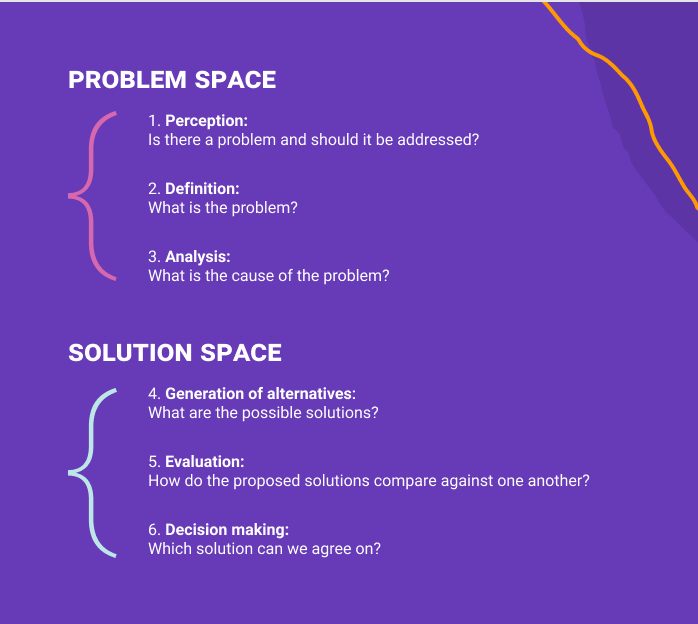
Fallback mechanisms
It is not always possible to reach a consensus.
Alternate viewpoints are sometimes too far apart to find any middle ground. In such situations, insisting on consensus can be time-consuming and ineffective.
Collaborative teams should devise a fallback mechanism for decision-making in situations where consensus is impossible. These mechanisms can be a hierarchical decision or a majority vote, a game of rock-paper-scissors, or any other pre-agreed model.
Having a fallback mechanism not only keeps the decision-making process on course, but it can also motivate the participants to work towards consensus, as consensus will always be perceived as preferable to the alternative.
It is important that the fallback mechanism is fully communicated and that the participants are aware of the consequences of failing to reach a consensus.
Principle #3: Design a process map
Collaboration does not take place spontaneously. It needs to be:
- Planned,
- Structured, and
- Facilitated.
Before collaboration can even begin, there is a multitude of information that must already be in place.
To fully commit, participants need to have a full understanding of how the collaboration will be conducted:
- How will the process function?
- Who will be involved and in what capacity?
- What are the specific responsibilities, timelines, resources? etc.
While it is impossible to fully foresee the course and the outcomes of collaboration, we can define the procedural framework and plan the processes of reaching a consensus and implementing the agreed solutions. We define the pathway towards action without knowing what the action will be.
Straus defines this procedural framework as a “process map”. It is a collectively defined and agreed set of roles and processes that predicts the steps in the collaborative process. Think of it as a well-structured meeting agenda, only on a higher level.
The process map needs to be sufficiently detailed in terms of the mechanisms of collaboration, yet flexible enough to facilitate the unpredictable trial-and-error nature of collaborative problem-solving.
If we take the meeting agenda as a micro-example of a process map, it does not predict the course of the discussion and any conclusions, but it can define the:
- Talking points,
- Specific roles,
- Timelines, and
- Other details that ensure that the meeting is conducted efficiently.
It can be a highly detailed document or a diagram, a combination of both, or even an unwritten verbal agreement between all participants. The important thing is to collectively define and clearly communicate the processes and the mechanisms of collaboration.
Aside from having a structured process, it also enables the participants to fully commit to the shared work with the assurance that it will be conducted in an organized manner.
Principle #4: Designate a process facilitator
In most collaborations, the shared problem solving and decision making are done in meetings. As so, meetings are a critical part of the collaborative process and their effectiveness is essential to the success of the joint effort.
Conducting an effective meeting includes multiple responsibilities:
- Defining a meeting agenda,
- Making sure that everyone has a chance to speak their mind,
- Record keeping, and
- Decision-making.
It is a big ask to expect someone to assume all these responsibilities AND actively participate in the discussion.
To relieve one individual of such a heavy load of responsibilities, Straus proposes the idea of shared responsibility for the success of the meeting between all participants. This involves differentiating roles and having different people attend to different aspects of the meeting.
Straus defines 4 distinct roles in a meeting:
- Facilitator: a neutral, impartial participant focused on the process
- Recorder: a person responsible for keeping records of the meeting
- Leader: senior manager, responsible for making sure that the team stays focused on the task at hand and, most commonly, making a decision if a consensus can’t be reached
- Group member: active participant focused on problem-solving
All participants are responsible for making sure that others don’t step outside of their roles. Namely, the facilitator prevents the leader from dominating the meeting, and the leader and group members ensure that the facilitator and the recorder remain neutral.
While we will pay closer attention to the role of the recorder in the following section of this article, we will now focus on the facilitator.
Ideally, a facilitator is someone outside of the collaborative group not immediately affected by the outcomes of the collaboration – for instance, an HR staff member. This is important to ensure neutrality and their focus on the process, and not the content of the meeting.
Hold team meetings over Pumble
Facilitator functions
The facilitator has 4 main functions:
- Process guide: responsible for the process of collaboration without evaluating or providing personal input to the discussion, as well as developing a meeting agenda and handling meeting logistics.
- Tool giver: responsible for offering process suggestions (different problem-solving and decision-making methods) and making sure that everyone is clear on the chosen method.
- Neutral third party: responsible for removing any conflicts of interest and excessive exertion of influence by honoring the process and ensuring that everyone’s input is heard and understood.
- Process educator: responsible for educating the participants about the process while they facilitate – demonstrating techniques (process planning, role clarification, basic problem-solving tools) that lead to consensus and productive collaboration.
Principle #5: Harness the power of group memory
Record meetings play an important part in the collaborative process. They not only serve as a record of the key talking points for later consideration, but can also play a role in moderating the meeting in real time.
Straus proposes a neutral role of a recorder whose sole responsibility is to capture the key ideas and conclusions presented in a meeting.
Additionally, all participants are responsible for the content of the record, as the recorder captures the key talking points in a transparent manner visible to all (i.e., on a chart pad, a whiteboard, or an interactive document).
The recorder should not paraphrase what’s been said, and the participants should correct the recorder if they disagree with the records. Straus dubs this collaborative approach to record keeping as “group memory”.
Keeping transparent meeting records in real time helps keep an efficient discussion and meeting objectives on track by providing clarity and avoiding repetition, confusion, and ambiguity.
In practical terms, Straus proposes that the meeting room seats are arranged in a U-shape facing a chart pad, so that all could follow the creation of records and make any corrections.
Of course, collaborative teams are free to explore and devise their own specific methods of keeping meeting records, provided they ensure transparency and the input of everyone involved.
9 Tips on creating a positive, productive team
Jon Gordon, the author of another influential teamwork book The power of a positive team, emphasizes the importance of positive energy in a team, which helps team members to get engaged and make a greater impact.
According to his belief, team members of positive teams have several crucial tendencies in common:
- They invest their time and energy to create a positive work environment,
- They work together toward a vision, which reflects a greater purpose, and
- They work with optimism.
So, let’s dig deeper into each of these behaviors and analyze how they make a positive impact.
Tip #1: Invest your time and energy to create a positive team culture
Team culture defines the team’s beliefs and expectations, which influence team members’ behaviors and the future of the team. As Gordon says, positive team culture is beneficial to its members in many ways:
- It improves connection among team members,
- It energizes and encourages team members, and
- It helps them to learn and grow.
Although leaders have a huge impact on the team dynamic, it’s created by all parties involved ― a team is dynamic, so every team member has an impact with their words, behaviors, and interactions with others.
Gordon believes that the most common mistake that teams make is focusing on the outcome or “fruit” instead of “root”— the process, relationships among team members, and their culture.
Furthermore, studies from Heart Math Institute indicate that we all broadcast to our team members how we feel. The attitude and energy of each team member are contagious — they affect the people around us.
Tip #2: Work toward a ‘shared vision’ with a greater purpose in mind
According to Gordon, key factors of every productive team collaboration are:
- A “shared vision” that inspires team members individually and collectively, and
- A greater purpose of why they are committed to that vision.
Unlike numerical goals, purpose-driven goals empower team members with greater commitment and energy. Thus, always attempt to identify the purpose of your team’s effort, rather than solely focus on the number you aim to achieve.
Most importantly, keep the vision and purpose alive. Gordon found that most teams let their vision and purpose fade away. Due to this issue, talking about these concepts on a regular basis is a must.
“It’s powerful to have each team member identify and share what the vision and mission mean to them and how they can contribute to it.”
Tip #3: See challenges as new opportunities
Every team has ups and downs ― failures are inevitable and natural. But, when a team encounters challenges, team members need to see it as an opportunity to learn and grow.
Instead of feeling frustrated about an obstacle, people need to try to grasp how to overcome it, and what they should learn from it for the future.
Tip #4: Implement the No Complaining Rule
Even though it’s human nature to complain, falling into such a negative mental habit is detrimental to maintaining healthy interpersonal relationships, as well as achieving personal goals.
People typically complain in order to communicate their dissatisfactions and feel understood.
However, if complaining is not followed by solutions, it is useless and toxic. Namely, research has shown that negative thoughts have a greater impact on our brains than positive thoughts.
Therefore, positive teams implement the “No complaining rule” ― do not complain unless you have a solution. With this rule, teams can successfully eliminate toxicity and empower team members to think and behave constructively by focusing on solutions.
🎓 Pumble Pro Tip
Most people have encountered a situation in which they were asked to take on extra responsibilities. Instead of complaining, learn how to professionally set boundaries. Check out our blog post:
Communicate your needs over Pumble
Tip #5: Disagree, but in a positive way
Even though some people tend to avoid disagreements in order to keep harmony and positivity in the workplace, constructive and respectful disagreements are a healthy part of team collaboration.
Gordon emphasizes the necessity of team conflict. If conflicts never happen, it means that no one is asking difficult questions or discussing important issues.
Most importantly, the absence of conflict indicates that no one challenges other team members’ opinions and criticizes others to improve.
So, disagreements can contribute to healthy and productive teams by providing better solutions and chances for growth.
Tip #6: Prioritize communication
Gordon says: “Communication is often the last thing you want to do, but it’s the most important thing you must do.”
Team communication is essential for building trust and commitment. To build a strong team, team members need strong communication, which implies abilities to:
- Talk effectively,
- Listen carefully,
- Receive feedback, and
- Use processed information to make decisions that are in the best interest of the team.
According to the 3C model of cross-functional teams, high-performing teamwork consists of three elements that represent related activities:
- Communication,
- Collaboration, and
- Coordination, which implies visibility of progress and directions of each team.
Therefore, these elements are core activities of every cross-functional team, as well as a functional team.
🎓 Pumble Pro Tip
Speaking of team communication skills, it’s very important to be an active listener. To enhance your active listening skills, make sure to check out our article:
A great way to strengthen team connection and collaboration is by having one-to-one conversations.
When it comes to communication between a team leader and team member, one-to-one meetings are an especially effective way to keep team members engaged and motivated.
Tip #7: Make time for one-to-one communication
More importantly, this is a valuable way to overcome challenges and encounter obstacles related to team collaboration.
Frequent and short one-to-ones are one of the most effective collaboration methods that help team members to stay on track and find their higher purpose.
Hold one-on-one meetings over Pumble
Tip #8: Communicate effectively with a team collaboration app
Speaking of the most effective communication practices, knowing which communication method to utilize is equally important as how we communicate with our coworkers.
Thus, choosing the right communication tool that meets the needs of the team is a priority and the only way to ensure effective team communication.
Pumble is a team collaboration software that helps remote teams blur the line between real and virtual communication and collaborate easily and effectively. With Pumble, you can:
- Work together in channels and DMs,
- Share files,
- Make voice and video calls, and more.
One of the greatest features of Pumble is a free chat history, so users can see the entire message history of all conversations from the beginning for free.
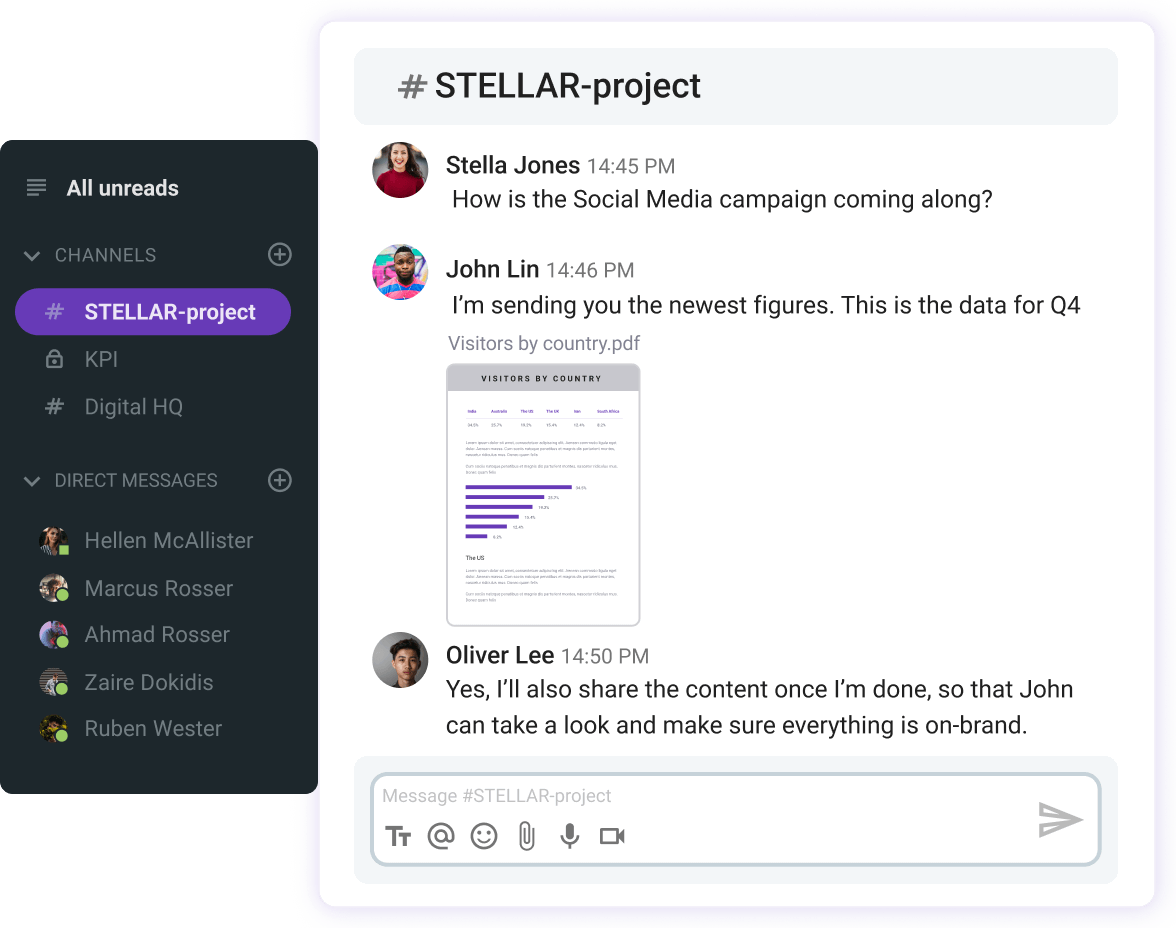
Tip #9: Don’t underestimate the power of team-building
Even though some people neglect the power of team-building, these activities are a key tool for improving teamwork collaboration and cohesiveness among team members.
According to a Forbes article, effective team-building is the most important investment of every successful organization, because it leads to:
- More engaged employees,
- Improved collaboration, and
- Good vibes among employees.
When it comes to team-building exercises, Gordon emphasizes the importance of fulfilling the following criteria:
- Vulnerability,
- Transparency, and
- Authenticity.
Team-building exercises that lead to people being vulnerable, transparent, and authentic are effective ways to shutter their ego and enhance the connection among team members. As a result, they have meaningful relationships and get more committed to the team.
Components of team-building activities, such as vulnerable storytelling, shared experiences, and common challenges are powerful ways to establish a positive work environment and enhance team collaboration and performance.
How to build team trust?
“Trust is the foundation of all teams, and without it, they cannot perform well.”
― Eric Coryell
In his teamwork book Revolutionize teamwork: How to Create and Lead Accountable Teams, Eric Coryell outlines effective principles for a productive group, which include team behaviors that increase trust and lead to better team performance and collaboration.
Instead of ignoring problems or bad-mouthing colleagues, Coryell is confident about the significance of addressing the real issues together.
Working together through the issues is beneficial for teamwork collaboration in the following ways:
- It brings different perspectives to the table and generates more options for solutions ― when all team members share their thoughts and different perspectives, the problem is more likely to be solved successfully and efficiently. Plus, everyone can contribute to problem-solving, which increases a sense of commitment.
- It increases transparency in the team and support among team members ― transparent communication reduces chances of miscommunication and talking behind someone’s back.
- It contributes to setting clear expectations and boundaries ― when team members address the issue and work through it together, group norms and boundaries can easily be set up.
- It strengthens the team and increases trust ― team relationships get enriched with more trust and commitment.
Ensure transparent communication with Pumble
The most common trust-breaking mistakes
Coryell emphasizes the significance of trust in teamwork and outlines the most common mistakes that damage trust:
- Bad-mouthing others before addressing a real issue, and
- The tendency of team members not to speak on their behalf.
Most people tend to talk about the issue behind the person’s back to get additional information or validate their point of view.
However, this practice is certainly an ineffective way to solve the problem. Even though some people feel better and get revealed when they do so, this behavior leads to long-term negative consequences that significantly can damage teamwork and trust.
Aside from talking behind others’ backs, avoiding talking for themselves is the most detrimental way to work through real issues.
People typically do so by using group pronouns, such as we or they. Instead of saying: “I noticed that you’ve been late to meetings lately”, some people say: “We noticed that you’ve been late to meetings lately.”
The main issues with the letter sentence are the following:
- The team member can easily get confused due to their ignorance of what you mean by “we”,
- They can conclude that you’ve already been talking to someone else about them without their knowledge, so here trust starts to break down.
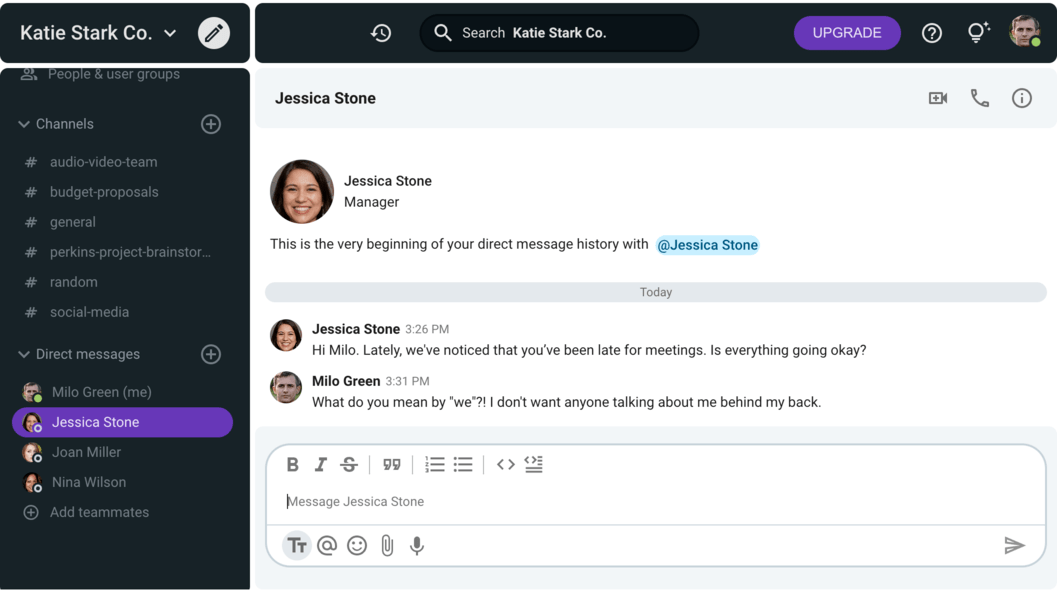
The second behavior that demonstrates avoiding speaking for themselves is asking a question instead of making a statement.
Most people usually ask suggestive questions when they want other people to agree with them, which is undoubtedly an ineffective communication practice.
For instance, they ask: “Don’t you think we should change our task priorities?” Instead, a more appropriate way to communicate is to say something like this: “I think it would be a good idea if we prioritized our tasks slightly differently.”
This way, you communicate assertively and demonstrate your respect, without passive-aggressiveness.
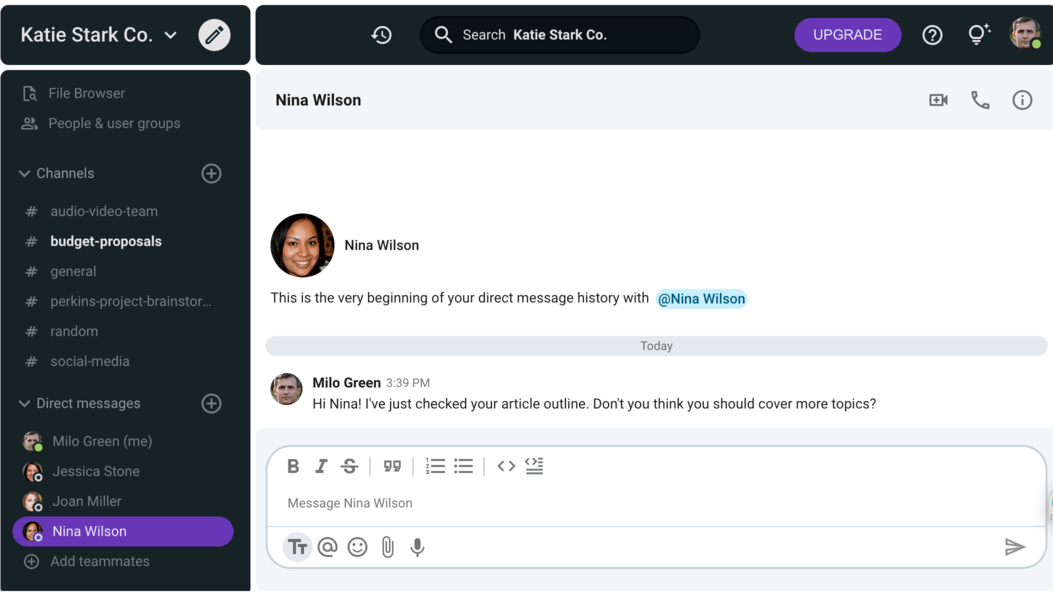
Foster assertive communication on Pumble
🎓 Pumble Pro Tip
To learn more about behaviors that lead to poor team communication, check out the following article:
How to build accountability and manage responsibility wisely?
One of the most common challenges that teams encounter is an inadequate approach to accountability management. In other words, it may happen that it’s not clear whether the leader or team members should take care of a certain issue.
Due to unclear expectations, the team may get stuck on unresolved issues, so it’s critical to make clear which decisions are the leader’s and which are the team members’ responsibility.
Aside from Straus’ six stages of building consensus that we’ve already discussed, there are several decision-making models, but one of the most common that successful teams implement is the RACI model.
Tip #1: Implement the RACI model
The RACI model can be implemented in various processes:
- Decision-making processes,
- Problem-resolution processes, and
- Project management processes.
According to the RACI model, regardless of the type of process, teams need to clarify who is:
- Responsible ― One or several people who are responsible for completing the task ― put differently, who owns the decision or problem. They are typically in development roles.
- Accountable ― The accountable people are usually managers or leaders, so they lead responsible parties to ensure they understand the expectations.
- Consulted ― Parties who are consulted before a decision is made, a problem is addressed, or the task is completed ― they provide input and feedback.
- Informed ― People who should be informed about the problem resolution, decision, or progress of the project. They usually work as heads, directors, or senior leaders.
Tip #2: Communicate expectations clearly
Every team member needs to know what is expected from them individually and collaboratively. Additionally, they all need to get feedback about their performance transparently and clearly.
Having performance conversations with your teammates or team leader timely and assertively contributes greatly to team collaboration and a good atmosphere in the team.
Instead of talking behind people’s back, one of the best teamwork practices is to communicate expectations, as it helps to:
- Build trust,
- Improve performance, and
- Increase commitment.
🎓 Pumble Pro Tip
If you are uncertain how and when to ask your manager for feedback, check out our blog post on the topic:
Tip #3: Lead by example
According to Coryell, two major factors that define leadership are:
- Leader’s behavior, and
- What they tolerate.
So, as a team leader, you can only change and improve your team if you modify your behavior and stop tolerating others’ behaviors that damage team trust and collaboration.
For instance, if you don’t want your teammates to talk about an issue without others’ knowledge, make sure you never do so.
If you are aware of the importance of making statements instead of asking passive-aggressive questions, stop tolerating this behavior in yourself and other teammates.
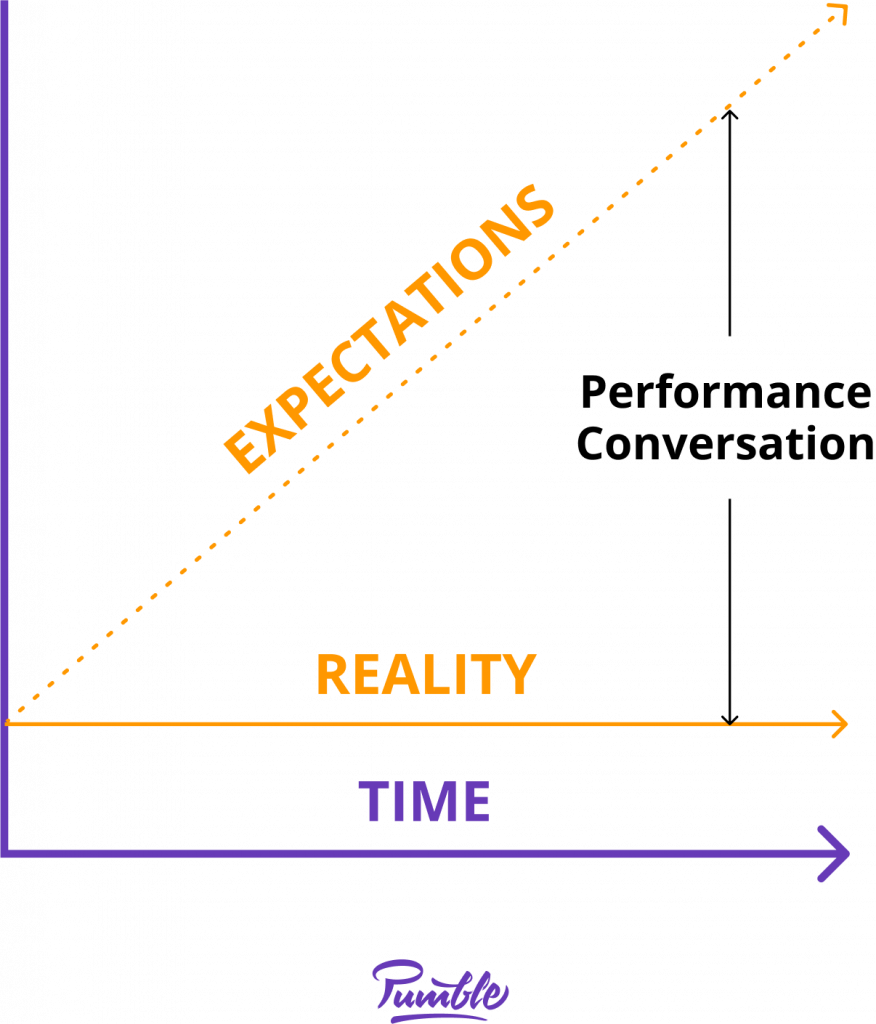
🎓 Pumble Pro Tip
If you want to learn more about effective leadership communication, check out our blog posts:
HR strategies that teach employees to collaborate and foster a sense of community
According to a Harvard Business Review’s article, studies have shown that two HR practices have a great impact on team performance and collaboration:
- Training employees to ensure collaborative behavior, and
- Supporting a sense of community.
The former HR strategy can make an important difference in team collaboration by improving employees’ skills in various areas, such as conflict resolution.
When it comes to supporting a sense of community as an HR strategy, it includes events and activities that make employees feel like a part of the community, which fosters a positive work environment.
Community in the workplace contributes to the meaningful connection among employees, which leads to more engagement and better connection to work.
To ensure productive team collaboration, team leaders need to be both task and relationship-oriented ― hence, implementing adequate HR strategies is certainly a great help to achieve so.
🎓 Pumble Pro Tip
Teamwork quotes help us understand the importance of effective team collaboration and communication. To find inspirational quotes for better collaboration, check out the following article:
Use Pumble to boost productive collaboration
Productive collaboration is a delicate process dependent on a variety of factors. As we mentioned before, effective communication is one of the most important ones that can be easily facilitated by using the right tools.
Pumble is the ideal team communication app for all teams looking to improve productivity and ensure company-wide success. Pumble can accommodate all diverse needs and preferences to create a seamless collaborative environment. With its intuitive interface and comprehensive features, Pumble fosters open dialogue, quick decision making, and efficient task and project management.
While productive collaboration requires careful attention to various elements, effective communication serves as its cornerstone. By leveraging tools like Pumble and nurturing a culture of collaboration, teams can overcome challenges, capitalize on opportunities, and ultimately drive organizational growth and success.
Enable your team to achieve greatness beyond individual capabilities — make a free Pumble account today.
How we reviewed this post: Our writers & editors monitor the posts and update them when new information becomes available, to keep them fresh and relevant.





